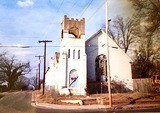Four Developments Create Current Day Belmont
Introduction
Author-Uploaded Audio
Listen to a narration of this entry's description by UNCC Urban Institute User.
Text-to-speech Audio
Images
Belmont Park Church

House United Home

Backstory and Context
Text-to-speech Audio
When the mill closed in 1957, the community continued as a white working-class neighborhood into the 1960s. Tom Hanchett, a local historian, found that as late as 1962, “there were virtually no Black residents in the survey area north of Belmont Avenue”. This changed when Brooklyn, Charlotte’s largest Black neighborhood, in what is currently Second Ward of Uptown, was razed as part of an Urban Renewal project. Between 1961 and 1970, more than 13 churches, 2 schools, and 1,480 homes across 238 acres were leveled. Not a single new residential unit was built, and more than 7,000 people were forced to find housing elsewhere. They were steered to the neighborhoods surrounding Uptown, including this area.
One Belmont resident recalls being displaced from Brooklyn and moving to Belmont as a young adult. She remembers “block busters” or white investors who convinced white homeowners to sell their homes at lower prices by stoking the fear of Black residents moving in. Urban renewal helped Charlotte expand its uptown, but it also ended up increasing both racial and economic segregation. The poorest families from Brooklyn were pushed into rentals and public housing, which had the result of concentrating poverty. The neighborhood entered a period of white-flight and disinvestment that lasted into the early 2000s.
Black-owned businesses were also displaced from Brooklyn, including the original Fatback Queen. A current resident, who was displaced from Brooklyn, remembers it as a gathering place with a big jar of fatback on the counter. A place where if someone had a dollar, they could eat and have a drink. Fatback Queen continued as a gathering place in its location in Belmont. While the building changed hands several times, the name remained in 2020.
Now cross 15th Street, walking north on Pegram Street to view 1201 Pegram Street on the left.
1201 Pegram Street was originally the Belmont Park Church. Now, this property is called The House United home. Half of the house was built at the 2012 Republican National Convention in Tampa, Florida, and the other half was built the following week at the Democratic National Convention in Charlotte. Delegates and elected officials from both parties worked alongside TV star Ty Pennington from “Extreme Makeover” fame to assemble the home for a grand reveal and to donate the completed house to a military veteran.
Let’s continue north on Pegram Street to the intersection of East 17th Street. You will cross Pegram Street and look for the medallion near the stop sign at the vehicle entrance of a school. This is the former site of the Belmont Park Vocational School.
